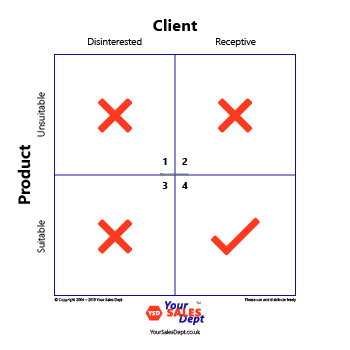
When Not to Sell
Avoiding sales rejection means engaging at the right time is what we all want to do, so engaging at the wrong time is what we want to avoid. The question then becomes, when is the right and when is the wrong time? That’s today’s exploration.
For the sake of clarity, a client is both a client or a customer, whichever fits your business best. Product also is a shorthand for product or service.
We have two axes on the chart, client and product. The client can either be receptive or disinterested. The product can either be suitable or unsuitable. See the diagram below for a clear representation of this idea.

Taking the numbered quadrants one by one, we get in #1, we have a disinterested client and the product is unsuitable, meaning there can be no engagement.
Now consider quadrant #2 we have a receptive client but the product is unsuitable, which, of course, means there will not be any engagement.
Next comes quadrant #3, here we have a disinterested client, but a suitable product, which also means there will not be any engagement.
However, in the last quadrant, #4 everything aligns. The client is receptive and the product suitable, which means now would be an appropriate time to engage.
As should be clear now, most of the options lead to a situation in which there can be no engagement, because something is wrong. Either the product is wrong or the client cannot or will not engage. This leads us to our sales rejection.
Sales Engagement not Sales Rejection
Now we can turn that frown upside-down and see how we can engage. It is clear the client has to be in a receptive mood or state of mind. The product needs to be something that solves a problem the client has. The best and perhaps only way to understand what the client thinks and their wants, needs, pains and fears are, is to look at the world from the client’s perspective. That means understanding the client, completing a Value Proposition and the associated Value Proposition Canvas. Then and only then will you understand the client. Of course, you only need to do this once for each targeted client type.
Move your own thinking into a structured mindset. Make sure you understand what the client wants and needs from your product. Fully understand their pains and fears, so you can speak to them as someone who understands them. Be prepared for them to say ‘No.’ They cannot say ‘Yes’, until they are ready. If for any reason, they are in quadrants 1-3, you cannot engage with them. Only in the final quadrant, #4, can you engage and, at that point, progress in making a sale is possible.
Do not waste your time on Sales Rejections, focus your time, energy and passion on quadrant #4, where a sale is possible, or at least, the first steps on the journey are possible. Until the potential client is ready, keep your name at the top of their mind.
Katherine Says
Knowing when to sell and when not to sell are equally important. It is all too easy to waste time, effort and energy trying to get in to see someone who is not ready to engage, let alone to buy. Getting the timing right is 90% of the battle. Pushing on an open door is so much easier than a locked door. Particularly if you want to go through.
This is why understanding the client, that is seeing the world from their perspective is so important. When you see the world as they do, their want, needs, pains and fears become clear to you. So does the correct time to approach them. For example, if you know a hotel will be busy during Christmas, then there is no point in trying to engage with them during one of their busiest times of the year. Wait until January when they will be more receptive. Saving you time, effort and energy. For more insight like this, contact me do discuss your needs.



